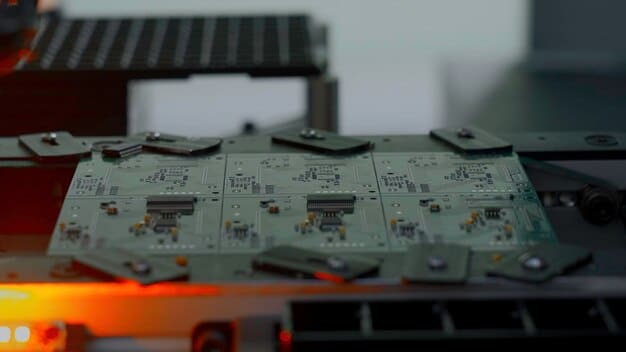US Defense Tech: How Semiconductor Shortage Threatens Production

The ongoing global semiconductor shortage significantly threatens US defense technology production by impeding the manufacturing of crucial military hardware, leading to potential delays, increased costs, and vulnerabilities in national security. This situation underscores the critical need for supply chain resilience and domestic production capabilities.
In a world increasingly reliant on advanced technology, the humble semiconductor has emerged as a cornerstone of modern existence. From smartphones to sophisticated military systems, these tiny chips power virtually everything. However, the global supply chain for semiconductors has been under unprecedented strain, raising critical questions about how this scarcity impacts the production of US defense technology. This article delves into the intricate challenges posed by the semiconductor shortage to America’s military industrial complex, exploring its profound implications for national security and technological readiness.
The Intricate Role of Semiconductors in Modern Defense
Semiconductors are the unseen engines of modern warfare. They are embedded in virtually every piece of advanced military equipment, from stealth fighters and precision-guided missiles to secure communication systems and surveillance drones. Their omnipresence means that any disruption in their supply chain directly translates to vulnerabilities in defense capabilities.
Modern defense systems require not just any chips, but often highly specialized, robust, and high-performance semiconductors. These are designed to withstand extreme conditions, operate under intense pressure, and provide reliable, real-time data processing. The reliance on these bespoke components adds another layer of complexity to the supply chain challenge.
Ubiquitous Integration Across Platforms
The extent to which semiconductors permeate defense technology is often underestimated. They are found in:
- 🛰️ Satellite communication systems and GPS units for navigation and targeting.
- 🚀 Advanced radar and sonar systems for detection and tracking.
- 🛡️ Electronic warfare equipment designed to jam enemy signals and protect friendly forces.
- 🤖 Autonomous and robotic platforms, including unmanned aerial vehicles (UAVs) and ground robots.
These examples barely scratch the surface, illustrating the profound dependence on a steady and secure supply of these critical components for maintaining technological superiority.
The sheer number and variety of chips required for a single military aircraft or vessel can be astounding. Each system, subsystem, and component often has its own set of unique semiconductor requirements, exacerbating the logistical challenges. This broad integration means a shortage in even one specific type of chip can halt the production of an entire, complex system, creating bottlenecks that ripple through the defense industrial base.
Furthermore, the rapid pace of technological innovation in defense demands constant upgrades and new generations of equipment, all of which rely on leading-edge semiconductor technology. This continuous need for new and improved chips keeps pressure on foundries and suppliers, highlighting the fragility of a global supply chain that isn’t fully under US control.
In essence, the semiconductor is no longer just a component; it is an foundational element, defining the capabilities, responsiveness, and effectiveness of contemporary defense forces. Its absence or scarcity directly impacts the ability to protect national interests and maintain global stability.
Origins and Evolution of the Semiconductor Shortage
The current global semiconductor shortage is a multifaceted issue, stemming from a confluence of factors that have converged over the past few years. While the COVID-19 pandemic often receives primary blame, its roots run deeper, reflecting intricate dynamics within the global economy and manufacturing landscape.
Initially, the pandemic triggered a surge in demand for personal electronics as work-from-home and remote learning became the norm. This spike in demand for consumer devices like laptops, webcams, and gaming consoles quickly overwhelmed existing foundry capacities. Concurrently, various industries, anticipating a prolonged economic downturn, cancelled or scaled back their chip orders, leading to inventory adjustments that further complicated the supply chain.
Key Contributing Factors
- 📉 Supply Chain Disruptions: Lockdowns, factory closures, and transportation bottlenecks disrupted the delicate global supply chain, which relies on intricate networks of specialized manufacturers across different countries.
- 📈 Sudden Demand Surges: An unanticipated rebound in sectors like automotive and consumer electronics post-initial pandemic shock caught chip manufacturers off guard, as they had already repurposed capacity or scaled back.
- 🔥 Geopolitical Tensions: Trade disputes and national security concerns have led to stockpiling and restrictions on technology transfers, particularly affecting chip exports to certain regions, further straining the global supply.
- 🏭 Limited Manufacturing Capacity: Building new semiconductor fabrication plants (fabs) is an incredibly capital-intensive and time-consuming endeavor, often taking years and tens of billions of dollars. The industry’s existing capacity simply couldn’t scale up quickly enough to meet the unforeseen spikes in demand.
The shortage was not uniform across all types of chips. Older, larger “legacy” chips, often used in automotive and industrial applications, were particularly hard hit, as foundries prioritized production of more profitable, cutting-edge chips for high-end electronics. This imbalance disproportionately affected sectors now critical to defense, which frequently rely on a mix of both advanced and mature technologies.
Moreover, natural disasters, such as fires at key chip factories and droughts affecting water-intensive manufacturing processes, have intermittently exacerbated the problem, illustrating the fragility of a highly concentrated production ecosystem. The heavy reliance on a few key manufacturers, primarily based in East Asia, means that disruptions in these regions have global repercussions.
This complex interplay of demand spikes, logistical challenges, geopolitical maneuvering, and limited manufacturing capacity has created a persistent and pervasive shortage, impacting industries worldwide and posing unique challenges for the demanding requirements of defense technology production.
Direct Impact on US Defense Technology Production
The global semiconductor shortage is not merely an inconvenience for the US defense industry; it poses a direct and tangible threat to the production timelines, costs, and ultimately, the operational readiness of vital military assets. The “just-in-time” manufacturing model, common across many industries, has proven particularly vulnerable in this crisis, as defense contractors find themselves waiting months, or even years, for critical components.
One of the most immediate effects is on the manufacturing pipeline for new equipment. Fighter jets, naval vessels, and advanced missile systems, which can require thousands of individual chips, face significant production delays. These delays translate into missed delivery targets, hindering the modernization efforts of the US military and potentially creating capability gaps on the global stage. Each delay means a new piece of equipment, vital for national security, is not yet deployed.
Escalating Costs and Obsolescence
The scarcity of semiconductors leads to increased prices for available chips, driving up the overall cost of defense programs. This can strain defense budgets, forcing difficult choices about where to allocate increasingly expensive resources. Moreover, some defense systems rely on older-generation chips that are no longer mass-produced, making them even harder to source amidst the broader shortage. This can lead to a cycle of accelerated obsolescence, where perfectly functional military hardware struggles to be maintained due to a lack of irreplaceable components.
The challenge extends beyond new production. The maintenance and upgrade of existing defense systems also suffer. If a critical chip fails in a piece of equipment currently in the field, finding a replacement can be a monumental task, potentially sidelining crucial assets and impacting readiness. This maintenance backlog creates a hidden vulnerability, as the effectiveness of the current fleet relies on the continued availability of components that are becoming increasingly scarce.

Furthermore, the shortage strains the relationship between the Pentagon and its defense contractors. Contractors, unable to secure chips, cannot fulfill their contractual obligations, leading to penalties, renegotiations, and a general atmosphere of uncertainty across the defense industrial base. This uncertainty can deter investment in research and development, further impeding the pace of technological advancement.
In essence, the semiconductor shortage has transformed from a supply chain hiccup into a critical national security concern, directly impacting the ability of the US to equip its forces, maintain its technological edge, and respond effectively to emerging threats. The intertwined nature of commercial and defense chip supply chains means that the military is not immune to the broader market forces affecting the global semiconductor industry.
Geopolitical Dimensions and Strategic Vulnerabilities
The global semiconductor shortage transcends mere economic disruption; it introduces significant geopolitical complexities and exposes strategic vulnerabilities for the United States. A substantial portion of the world’s most advanced semiconductor manufacturing capacity is concentrated in a few key regions, particularly East Asia, making the US dependent on external suppliers for critical components.
Taiwan, through the Taiwan Semiconductor Manufacturing Company (TSMC), provides over 90% of the world’s most advanced chips. This singular reliance creates a significant geopolitical risk. Any instability in the region, a natural disaster, or a geopolitical conflict involving Taiwan could severely cripple the global supply of high-end semiconductors, with catastrophic implications for US defense and economic security.
Competitor Actions and Supply Chain Risks
- 🇨🇳 China’s Ambitions: Beijing’s drive for semiconductor self-sufficiency and its efforts to integrate civilian and military technology (military-civil fusion) pose a long-term challenge. China’s potential for aggressive actions concerning Taiwan or its control over rare earth minerals, vital for chip manufacturing, adds another layer of geopolitical risk.
- 🤝 Allied Dependencies: Even close allies like Japan, South Korea, and European nations are critical players in different segments of the semiconductor supply chain, from specialized equipment to raw materials. Disruptions in these relationships or internal instabilities could impact US access to necessary components.
- 🛡️ Export Controls and Trade Wars: The use of export controls as a strategic tool by various nations can exacerbate the shortage. While designed to limit technology transfer to adversaries, these controls can inadvertently disrupt broader supply chains and trigger retaliatory measures, creating a more fragmented and less efficient global market.
The heavy reliance on just-in-time manufacturing models, while efficient in stable times, has proven to be a strategic liability during crises. Small disruptions at any point in the intricate global supply chain – from raw material extraction to final assembly – can cascade into major bottlenecks, directly impacting defense production timelines. This lack of redundancy or alternative suppliers leaves the US vulnerable to external pressures and unforeseen events.
Moreover, the sophisticated nature of chip manufacturing means that simply building new fabs domestically isn’t a quick fix. It requires not only immense capital but also a highly specialized workforce, access to state-of-the-art equipment (often from a limited number of global suppliers), and complex intellectual property. This makes rapid reshoring efforts exceptionally challenging, underscoring the deep-seated nature of this strategic vulnerability.
The geopolitical landscape surrounding semiconductors is a high-stakes arena. Ensuring a resilient and secure supply chain for defense technology is not just about economics; it’s about safeguarding national sovereignty and maintaining global strategic parity in an increasingly technological world.
US Strategies to Mitigate the Semiconductor Shortage
Recognizing the profound implications of the semiconductor shortage, the United States government and industry stakeholders have initiated a range of strategies aimed at mitigating the immediate crisis and building long-term resilience. These efforts span legislative action, increased domestic investment, and diplomatic engagement.
A flagship initiative is the CHIPS and Science Act, signed into law in 2022. This bipartisan legislation allocates over $52 billion to boost domestic semiconductor research, development, and manufacturing. The goal is to incentivize companies to build new fabs and expand existing ones within the US, reducing reliance on overseas production and diversifying the global supply chain.
Key Mitigation Approaches
- ➡️ Domestic Manufacturing Incentives: The CHIPS Act provides grants, loans, and tax credits to semiconductor companies to establish or expand production facilities in the US. This aims to create a more robust domestic ecosystem for chip design, fabrication, and packaging.
- 🤝 International Partnerships: The US is actively pursuing “chip diplomacy” to strengthen supply chain security with allied nations. This includes dialogues with major semiconductor producers like Taiwan, South Korea, and Japan to coordinate strategies, share information, and potentially diversify sourcing.
- 🔬 Research and Development Investment: Significant funding is being directed towards R&D in advanced semiconductor technologies. This includes exploring new materials, manufacturing processes, and chip architectures to ensure the US remains at the forefront of innovation and develops next-generation capabilities.
- 📚 Workforce Development: Addressing the shortage of skilled labor needed for semiconductor manufacturing is crucial. Initiatives are underway to expand educational programs, vocational training, and apprenticeships to cultivate a robust talent pipeline for the industry.
Beyond legislative action, the Department of Defense (DoD) is actively working with defense contractors to identify critical chip dependencies and explore alternative sourcing options. This includes assessing the use of common, readily available chips where possible, rather than relying solely on highly customized components, though this has limits given defense requirements.
The DoD is also exploring “trusted foundry” programs, which aim to ensure a secure supply of specialized, high-reliability chips for sensitive military applications. These programs involve rigorous security protocols to prevent tampering or counterfeiting, adding another layer of complexity to sourcing.

Furthermore, there’s a growing emphasis on creating “digital twins” and advanced modeling to better predict supply chain disruptions and identify vulnerabilities before they impact production. This proactive approach aims to improve resilience through data-driven decision-making and better inventory management practices.
While these strategies represent a robust response, their full impact will take time to materialize. Building new fabs and training a specialized workforce are multi-year endeavors. However, these efforts signify a crucial shift towards a more resilient and strategically independent semiconductor supply chain for US defense technology.
Future Outlook and Long-Term Implications for US Defense
The global semiconductor shortage is unlikely to be a short-term anomaly; its effects will ripple through the US defense industrial base for years to come, fundamentally reshaping how defense technology is produced, procured, and integrated. The immediate crisis has illuminated deep-seated vulnerabilities, prompting a strategic re-evaluation that extends beyond simply increasing chip production.
In the long term, the US defense sector will likely witness a sustained push towards greater supply chain traceability and transparency. This involves a more granular understanding of where every critical component originates, who manufactures it, and the potential risks associated with each node in the supply chain. This heightened vigilance aims to prevent future disruptions and mitigate geopolitical leverage.
Key Future Trends
- 🌐 Localization and Regionalization: While complete self-sufficiency is impractical, there will be a continued drive for greater domestic and allied regionalization of semiconductor manufacturing. This “friend-shoring” or “ally-shoring” approach aims to create more secure and redundant supply chains within politically stable and trusted blocs.
- 🚀 Focus on Advanced Packaging: Beyond raw chip fabrication, there will be increased investment in advanced packaging technologies. This crucial step, where individual chips are integrated into complex systems, offers an opportunity to add value and control closer to home, even if some base chips are manufactured overseas.
- 🔄 “Design for Resilience”: Defense engineers will increasingly adopt a “design for resilience” mindset. This involves designing systems that can accommodate a wider range of chip types, promoting modularity, and incorporating redundant components to reduce single points of failure related to semiconductor availability.
- 🛠️ Maintenance and Sustainment Innovation: The challenge of maintaining existing fleets will spur innovation in sustainment. This includes increased use of predictive maintenance, additive manufacturing (3D printing) for replacement parts (where feasible), and enhanced digital inventories of components.
The accelerated pace of technological competition, particularly with peer adversaries, means that maintaining a technological edge is paramount. The semiconductor shortage, therefore, underscores the urgency of sustained investment in cutting-edge research and development. The race for “next-generation” chips – smaller, faster, more energy-efficient – is now inextricably linked to national security.
Furthermore, the workforce challenge will remain significant. Attracting and retaining top talent in highly specialized fields like semiconductor engineering and manufacturing will be critical. This requires ongoing investment in STEM education and fostering a culture of innovation that encourages the brightest minds to contribute to national defense technology.
Ultimately, the semiconductor shortage serves as a potent wake-up call for the US defense industry. It mandates a shift from globalized efficiency to strategic resilience, prioritizing security of supply and domestic control over cost optimization alone. The long-term implications point towards a more diversified, secure, and strategically independent defense technology ecosystem, though the journey to achieve this will be complex and challenging.
| Key Aspect | Brief Description |
|---|---|
| 🛡️ Defense Dependence | Modern US defense relies heavily on specialized semiconductors for all advanced weaponry and systems. |
| 🚧 Production Delays | Shortages lead to significant delays in manufacturing new military equipment and maintaining existing fleets. |
| 🌍 Geopolitical Risk | Concentrated chip production overseas exposes strategic vulnerabilities to the US. |
| 💡 Mitigating Strategies | US is investing in domestic production, R&D, and international partnerships to build resilience. |
Frequently Asked Questions About the Semiconductor Shortage and US Defense
Semiconductors are the fundamental components powering nearly all modern military systems, from advanced radar and communication networks to precision-guided munitions and stealth aircraft. They enable the complex calculations, data processing, and integrated functionalities that define contemporary defense capabilities, making their availability directly linked to national security and operational readiness.
The shortage directly leads to significant production delays for new military equipment like fighter jets, naval vessels, and missile systems. Many parts of a single weapon system require numerous specialized chips. When these components are unavailable, manufacturing lines halt, causing project backlogs, driving up costs, and delaying the deployment of critical assets vital for modernizing the US military fleet.
The concentration of advanced chip manufacturing in East Asia, particularly Taiwan, exposes the US to significant geopolitical risks. Any instability, natural disaster, or conflict in these regions could severely disrupt global chip supply, directly impacting US defense capabilities. This dependence on external sources creates strategic vulnerabilities and potential leverage for adversaries.
The US government has enacted the CHIPS and Science Act, allocating over $52 billion to incentivize domestic semiconductor manufacturing, research, and development. This aims to reduce reliance on foreign production. Additionally, the US is forging stronger international partnerships and investing in workforce development to build long-term resilience and secure its supply chain.
Yes, the implications are long-term. The shortage is prompting a fundamental shift towards greater supply chain resilience, transparency, and domestic production capabilities. It’s driving increased investment in advanced R&D, a focus on “design for resilience,” and efforts towards “friend-shoring” to ensure more secure and diversified access to critical components for future defense technologies.
Conclusion
The global semiconductor shortage represents a significant, multifaceted challenge to US defense technology production, extending far beyond simple supply chain hiccups. It has laid bare critical vulnerabilities within the nation’s industrial base, exposing the precarious balance between global efficiency and national security. From delaying the deployment of cutting-edge military hardware to escalating costs and exposing geopolitical risks, the impact of chip scarcity is profound and far-reaching. However, the crisis has also served as a powerful catalyst for strategic change. Through legislative action, robust investment in domestic manufacturing and R&D, and strengthened international partnerships, the United States is actively working to fortify its semiconductor supply chain. While the path to complete resilience will be complex and lengthy, these concerted efforts underscore a crucial pivot towards securing America’s technological advantage and ensuring its defense readiness in an increasingly interconnected and unpredictable world. The lessons learned from this crisis will undoubtedly shape the landscape of defense technology for decades to come, fostering a more robust, secure, and strategically independent industrial base.





